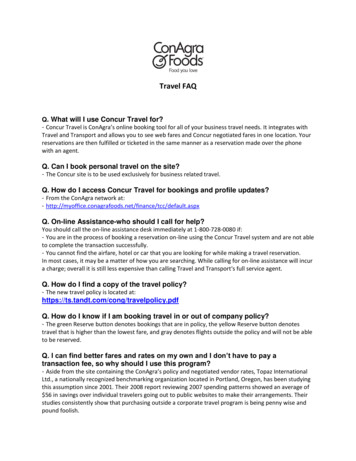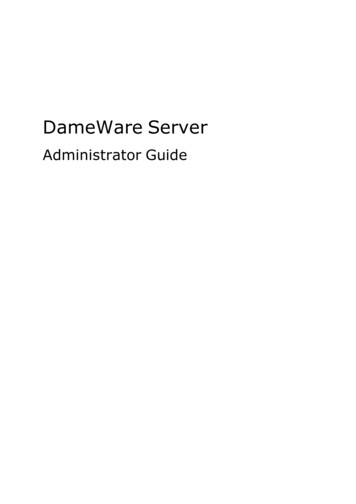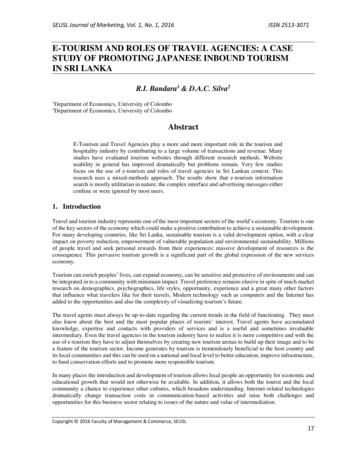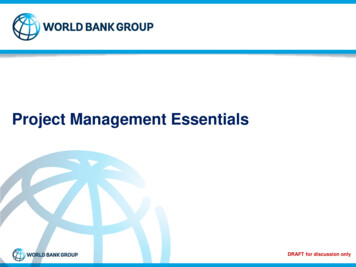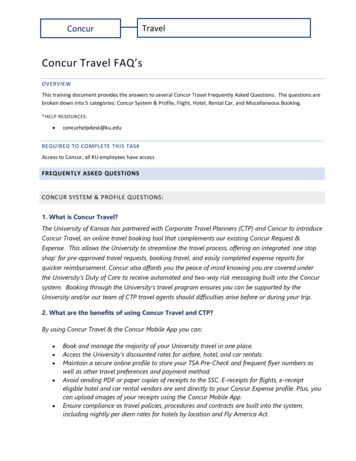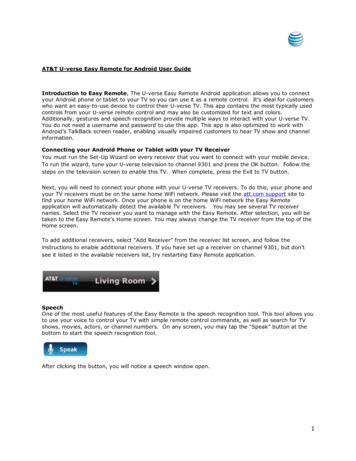
Transcription
REMOTE TRAVELPLANNING & RESOURCEGUIDE(C) Copyright 2003 University of AlaskaPublished by the University of Alaska Risk Management Teamc/o System Office of Risk Services, University of Alaska,Fairbanks, Alaska, 99775-5240Risk Management Team ContactsThe University of Alaska provides equal education and employment opportunities for all, regardless of race, color, religion, national origin, sex,age, disability, status as a Vietnam era or disabled veteran, marital status, changes in marital status, pregnancy, or parenthood, pursuant toapplicable state and federal laws.6/9/2003
TABLE OF CONTENTSI.INTRODUCTION AND PURPOSE . 4II.OVERVIEW . 5A. Planning . 51. Remote Travel Pre-Trip Plan & Authorization . 52. Remote Travel Emergency Plan 53. Survival Kit Check List . . 5B. Training . 51. Required Training for Remote Travel 52. Recommended or Trip Specific Training and/or Travel Requirements . 63. Training Resources, Topics, and Schedules . . 6C. Insurance, Permits, & Indemnification . 61. Insurance Guide . 7III.SAFETY AND SURVIVAL TIPS .8IV.BASIC SAFETY 9A. Travel . 91. Communications 92. Motor Vehicle Travel . 93. Boat Travel .104. Air Travel . 105. Snowmachines, ATVs, Four-Wheelers . 116. Travel on Foot 117. Other Transportation Modes . 128. Survival in Emergency Situations . 13B. Equipment, Body Gear, Food & Shelter 141. Field Equipment 142. Body Gear . 15a. Clothing 15b. Footwear . 16c. Hand, Face and Head Protection . 163. Food and Shelter . 16a. Food . 16b. Water 16c. Shelter. . 17(1) Winter 17(2) Summer . 18(3) Unoccupied cabins/shelters 18d. Fire 18C. Health Concerns . 191. Frostbite . 192. Hypothermia . 212
3.4.5.6.7.8.9.10.11.Carbon monoxide poisoning . 22Giardia 23Snow Blindness . 23Immersion Foot . 23Insect Bites . 24Fish Poisoning 24Jellyfish Stings . 24Devils Club 25Paralytic Shellfish Poisoning . 25D. Wild Animals . 261. Bear Safety . 262. Moose and Other Large Animal Safety . 273. Animal Bites and Rabies 27E. Distress Signals . 28V.FIREARMS 29VI.EMERGENCY CONTACTS 30VII.APPENDICES . 31Appendix A.Appendix B.Appendix C.Appendix D.Appendix E.Appendix F.Appendix G.Appendix H.Appendix I.Appendix J.Appendix K.VIII.REFERENCES . 50A.B.C.D.E.F.IX.Remote Travel Pre-Trip Plan & Authorization Form 32Remote Travel Emergency Plan 34Survival Kit Check List . 37First Aid Kit Check List . 38Highway Travel Equipment Check List . 39Boat Travel Equipment Check List 40Emergency Rations and Equipment List for All Aircraft In Alaska . 41Visual Signals Between Ground and Aircraft 42UA Field Stations and Facilities . 43Wind Chill Chart 45Comments and Advice from University Graduate Students, Staff, & Faculty . 46Planning . 50Travel 50Clothing, Shelter, Food, and Water . 50Health, Safety, and First Aid 50Survival in an Emergency . 51Mountaineering . 51DISCLAIMER 352
UNIVERSITY OF ALASKAREMOTE TRAVEL PLANNING & RESOURCE GUIDEI.INTRODUCTION AND PURPOSETravel in remote areas of Alaska presents many challenges. This Guide is to be used as a training,preparation, and resource tool for University of Alaska students, faculty, and staff who will travel toremote areas for business, research, or recreation. Emphasis is placed on the inclusion of informationspecific to field work in Alaska that is not easily found elsewhere. Information is included on modesof travel, clothing, food and water, health, safety, subsistence, and survival techniques. It isrecommended that all supervisors, graduate student major advisors, research principal investigators,student affairs personnel, student organizations, rural faculty, and any other University of Alaskaaffiliated individuals traveling in remote areas be familiar with the contents of this Guide and usepertinent sections for preparation and training on how to work and recreate safely in the wilderness.Planning for remote travel in Alaska is crucial as individuals are typically removed from sources ofsupplies and medical assistance. The goal of this guide is to increase awareness and knowledge ofwilderness travel health and safety issues and promote the best possible chance for crisis free trips.There are several additional training and preparation recommendations or requirements that should becompleted to supplement the information and advice found in this Guide. For example, First Aid andCPR training and certification, firearms usage, wildness survival, or water safety may be part of yourpreparation, depending on where you are heading, the size of your group, or the kinds of wildernessyou anticipate you will encounter. References are given at the end of this Guide for publishedinformation available on other important field safety topics such as mountaineering. Prepareaccordingly to minimize potential adverse impacts. You will be required to complete the variouschecklists referenced herein and obtain all required approvals for activities PRIOR TO travel.4
II.OVERVIEWA. PLANNINGNo matter how much advance planning you do, there is always a chance that something will gowrong and you will need to use your wits as well as your experience to solve the problem.Nothing can substitute for a positive mental attitude in those situations. If you have done yourplanning well, including advance thought about the emergencies which you might encounter, youwill know that you have the capability to survive and to help your companions to survivewhatever the situation may be. Keep your wits about you, and remember that your best resourceis yourself.There are three required plans/checklists that must be completed and attendant tasksaccomplished before each field season or remote trip. Several other check lists are provided inthe appendices of this guide to assist you in your planning purposes.1) Remote Travel Pre-Trip Plan & Authorization: Prior to each trip, a detailed plan thataddresses trip-specific details must be prepared, approved and communicated with appropriatepersonnel prior to finalizing the trip plans and encumbering funding. This pre-trip plan mustprovide specific information regarding participants, trip route, conveyance methods,communication and emergency plans, and training needed relevant to the trip. An approvalprocess for remote travel should be established at each campus. This form can be found inAppendix A.2) Remote Travel Emergency Plan: This plan is to be completed and left on file to record tripspecifics, communications and emergency plans. It must be approved in accordance with yourcampus policy or procedure prior to departure. This form can be found in Appendix B.3) Survival Kit Checklist: This check list will help you put together your survival kit and can befound in Appendix C.B. TRAININGTraining for a successful remote travel includes relevant preparation of the participants. If youfind that a necessary training topic is not available at your institution, consult with yourdepartment head or risk/safety departments for assistance in obtaining the appropriate training.1) Required Training for Remote Travela. CPR and First Aid – The University of Alaska requires that at least one employee in eachremote travel group have current certifications in first aid and CPR (cardiopulmonaryresuscitation).b. Driver Training – If travel plans include driving, the designated drivers much possesscurrent University-issued driver training certification in addition to a valid State of Alaskadriver’s license with endorsements appropriate to the vehicle to be driven and its cargo. Inaddition, drivers must be accepted under individual MAU driving requirements.2) Recommended or Trip Specific Training and/or Travel Requirements5
Department deans and directors, in conjunction with campus/institute risk management andsafety professionals, will define training programs and determine trip specific trainingrequirements. Depending on travel location, duration and anticipated hazards, training andrequirements may include: Bear protection Boating safety Aircraft safety Wilderness survival ATV safety Firearm safety Physical Examinations Hepatitis A or other vaccinations Special Vehicle Operations Hazardous Materials Awareness Permits and Fees Diver certification (current) and coordination with UAF Diving Committee requiredPRIOR to trip. See: http://www.sfos.uaf.edu/dive/ for further information.3) Training resources, topics, and schedules can be found at the following web sites:UAA: http://ehsrms.uaa.alaska.edu/UAF: http://www.uaf.edu/safety/welcome.htmUAS: http://www.uas.alaska.edu/facilities services/safety/SW: http://www.alaska.edu/risksafety/c ehs/C. INSURANCE, PERMITS & INDEMNIFICATIONInsurance options should be explored and coverage procured, if needed, well in advance of travel.Below is a chart of the various insurance programs and options available. Each participant on aremote travel assignment is individually responsible for securing adequate insuranceprotection for themselves, whether through a University of Alaska program or privateinsurance. Accident insurance is strongly recommended for student participants if they do nototherwise have insurance available to them.Many governmental entities are beginning to require permits, certificates of insurance, and bondsfor travel in their jurisdictional areas. Contact your local risk management office for assistance inobtaining this coverage and processing the required paperwork. In addition, most permits containindemnification agreements that must be approved by the office of General Counsel PRIOR to thedepartment signing. Therefore, begin the permit/application process well in advance of your trip(a MINIMUM of two weeks) so that you can avoid any last minute hold-ups due to insurance orlegal problems.6
1.INSURANCE GUIDEFOR UA EMPLOYEES(Includes eligible volunteers and graduate students on stipend – for eligibility confirmation call907-450-8157.)Except for the health insurance which covers only benefit eligible employees, the followingcoverages are automatic for all employees and do not require application:InsuranceCoverageContactBlue Cross BlueHealth InsuranceCampus Human Resource Department or:Shield of Alaska(non-work relatedhttp://www.alaska.edu/hr/(For Healthmedical conditions)Benefit EligibleEmployees Only)Workers’On the Job Injuries orSystem Office of Risk ServicesCompensationIllness907-450-8156 or 1-800-478-8632 (in state only)http://www.alaska.edu/risksafety/e claims/file-aclaim/workers-compensation/Travel AccidentAccidental Death &Statewide Office of Risk ManagementInsuranceDismemberment &907-450-8157 or 1-800-478-8632 (in state only)Assistance Serviceshttp://www.alaska.edu/risksafety/b gn TravelLiability Coverage,Statewide Office of Risk ManagementIncluding Auto Liability, 907-450-8157 or 1-800-478-8632 (in state only)& Assistance Services.http://www.alaska.edu/risksafety/b insurance/insurance-coverage/foreign-liability/FOR UA STUDENTSThis coverage is NOT automatic. Students or departments must apply for this insurance coverage:Student TravelAccident Insurance (does Statewide Office of Risk ManagementAccidentnot include health907-450-8157 or 1-800-478-8632 (in state only)http://www.alaska.edu/risksafety/b insurance/insuInsurancecoverage, e.g.appendicitis, heartrance-coverage/student-accident/problems, etc.)Student HealthHealth InsuranceUAA Student Health Center: 907-786-4040InsuranceMega Life Student Insurance:1-800-767-0700 or https://www.uhcsr.com/UAF Student Health Center: 907-474-7043http://www.uaf.edu/chc/index.htmlUAS Student Resource Center: .htmlFOR NON AFFILIATED PARTICIPANTS7
Visitors from other institutions and other non-affiliated persons must procure their own insurancecoverage. UA does not have the ability to provide insurance protection to non-affiliated individualsother than for those who qualify through the Foreign Visitor Insurance program. For furtherinformation about this coverage or for questions, please contact the System Office of Risk Services907-450-8157 or 1-800-478-8632 (in state only),http://www.alaska.edu/risksafety/b insurance/insurance-coverage/foreign-visitor/If a UA sponsored remote trip will involve non-affiliated persons, please contact your localrisk/safety office for consultation on best course of action for insurance options.UAA: http://www.uaa.alaska.edu/ehsrms/UAF: http://www.uaf.edu/safety/UAS: http://www.uas.alaska.edu/facilities services/safetyIII.SAFETY AND SURVIVAL TIPSSuccess and survival depend on planning, timing, common sense, and the intelligent use of suppliesand equipment. Following are some wilderness survival tips.1. You must help yourself, don't depend on someone else to think and plan for you. Confidence inyour own abilities and your will to live can make the difference between life and death.2. Whether in camp, in a vehicle, on foot, or in the water or air, always have a plan in case of anaccident. Carry your survival kit with you whenever you leave camp.3. Never leave camp alone. There should be at least two people per party when traveling in remoteareas.4. Tell someone where and when you are going and when you expect to return. Check in when youreturn. The same holds true if you must travel away from a downed plane or other vehicle; leavea message saying when you left and the direction you were headed.5. Don't fight the environment. Conserve your energy - go around obstacles, not over or throughthem. Wait out high winds and other adverse weather.8. Fuel stoves outside tents or shelters; fumes could be toxic or could cause an explosion.9. Don’t light or use cooking stoves inside unventilated tents.10. Make sure your tent is fire-resistant if you are going to have any open flames in it.11. Do not pack liquid fuel for stoves with food; a spill could contaminate and ruin your food.12. Store emergency food, gear, shelter, and sleeping protection away from main camp area; “do notput all your eggs in one basket.”13. In an emergency situation, do not overeat, but be sure to drink plenty of water. You can probablysurvive without food for a week or more, but you cannot survive without water.8
IV.BASIC SAFETYA. TRAVEL1. CommunicationsThere are a variety of transportation modes that may be employed on remote travel trips.Each type of travel requires different knowledge and preparation. Regardless of the modeof transportation chosen, communications in an emergency situation are of utmostconcern. When traveling, make sure that a means of communication such as a satellitephone, radio, cell phone (if you will be within coverage range), or emergency locatorbeacon are include in your emergency survival kits. Schedule periodic radio or telephonecommunication with a base of operations whenever you are traveling and document theschedule in your Remote Travel Emergency Plan (Appendix B).2.Motor Vehicle TravelA Highway Travel Equipment Checklist can be found in Appendix E. This checklist canbe modified dependant upon the season, location, and length of your trip.Cars and Trucks: The Alaska Section of Community Health and Emergency MedicalServices (EMS) and the Alaska Highway Safety Office publishes a brochure entitled HelpAlong the Way - Emergency Medical Services For Alaska Travelers that can be found onthe web at: dfThis is an excellent brochure providing emergency contact information for places alongthe major Alaska highway systems, including the marine highway. Other general safetyinformation is included such as a suggested list of emergency equipment to carry in yourcar, first aid information, and accident procedures. Copies of this brochure can be printedfrom your computer or can be obtained at the EMS office in each major Alaskan town.Emergency equipment should be carried in your vehicle. A vehicle will provide shelter ifyou are stranded. If there is injury, the blankets, extra clothing, water, etc. will helpoccupants survive until assistance arrives.Buses and Vans: Special safety precautions exist for travel in these vehicles. Driversmust be certified in accordance with any applicable laws, regulations, or policies throughyour campus driver training program:UAA: http://www.uaa.alaska.edu/ehsrms/UAF: http://www.uaf.edu/safety/UAS: http://www.uas.alaska.edu/facilities services/safetyIf stranded, do not leave the vehicle unless absolutely necessary. The headlights fromyour vehicle can be used to signal potential rescuers. However, do not continue to usethem for extended periods of time, as the battery will become quickly depleted,particularly in colder temperatures. Do not run the vehicle continuously. Make sure thetail pipe is clear of snow and mud. NEVER GO TO SLEEP IN A RUNNINGVEHICLE. Make sure you have adequate ventilation, with a window slightly open. Ifpossible, face the vehicle into the wind so that vehicle exhaust won’t be drawn inside.9
See section on Carbon Monoxide Poisoning, section IV.C.3, or further information if youare stranded with a vehicle.3. Boat TravelA Boat Travel Equipment Checklist can be found in Appendix F. This checklist can bemodified dependant upon the season, location, and length of your trip.Loading a boat safely is important. Keep the center of gravity low (don't stack gear toohigh). Distribute the weight of your gear evenly along the length of the boat. Do notdepart if water conditions are not conducive for safe travel. Be aware of high water fromrain, snow melt, or glacier melt, fast and unpredictable currents or tides, turbid water,floating debris, high winds and geographical features as these conditions may causehazards. All participants must wear Coast Guard rated and approved life vests wheneverthey are on a watercraft. When traveling in any boat, be prepared in case you land in thewater. Keep your gear dry, including survival kit. Pack everything in heavy dutywaterproof bags attached to a flotation device. Motorized Craft: Carry maps, tools, and parts for engine repair with you inmotorboats. Make sure the vessel has the standard Coast Guard approved equipmenton board. Rafts: A raft will need specialized provisions, including a manually operated airpump, a patch kit, rolls of duct tape, a bow rope, and bailing buckets (unless the raft isself-bailing). Rafts are generally rated by maximum allowable weight. Rafts must notbe loaded with supplies beyond their rated weight capability, and cargo should besecured at all times while on a moving body of water. Canoes: Canoes are generally not rated for more than two people, are inherentlyunstable, and subject to easy tip-over even in calm water. Canoes are notrecommended for use on open seas. Much of the same advice provided for rafts is alsoapplicable for canoes. Special training to use a canoe should be obtained before usingone on a remote trip. Kayaks: A kayak is quite similar in application to a canoe, except that a kayak can beused on open seas with proper skirting. Special training to use a kayak should beobtained before using one on a remote trip.4. Air travelAn Emergency Rations and Equipment List for All Aircraft in Alaska (from Alaska statute02.35.110) can be found in Appendix G.Section 02.35.110. of Alaska Statute requires aircraft pilots to provide emergencyequipment and rations for each and every flight within the state. Be sure that the ownerand/or pilot confirms that the required survival gear is on board. Weight distribution isextremely important; let the pilot load the plane.As an individual, be prepared in case of the crash of a light plane. Dress to survive theworst terrain and climate over which your air route will take you. Carry extra clothes and10
your emergency survival gear. Since exiting a downed aircraft may be difficult, a hacksaw, pry bar, large pliers and other tools should be in an accessible place known to allpassengers. Wear leather gloves while traveling in small aircraft to provide the ultimateprotection to your hands. Do not smoke around fueling operations.Do not let yourself be dropped off by a pilot without a sleeping bag and your survival kit.The weather may turn bad before the rest of the gear can be flown in.Helicopter Safety and Etiquette: If possible, deploy some light weight material as a wind sock to indicate wind directionto the pilot. Wait for directions from the pilot before approaching the aircraft. AFTER the pilot has acknowledged your presence and you are cleared to approach theaircraft:o Approach or leave in pilot's field of vision, usually from the front of the aircraft.o Approach or leave machine in a crouching manner (to stay below the mainrotor).o Stay away from the tail rotor.o Approach or leave on the down slope side.o Carry tools horizontally and below waist level, never upright or over theshoulder. Fasten seat belt after entering helicopter and leave it buckled until pilot signals you toget out. Never leave the helicopter while it is at a hover. Do not touch bubble or any moving parts (tail rotor, exposed linkage, etc.). Do not slam the helicopter doors. Wear survival clothing in flight, up to the waist, in case of an emergency. Keep heliport clear of loose articles (water bags, empty cans, etc.). Keep people away from helicopter during takeoffs and landings. Keep cooking and heating fires well clear of helicopter.5. Snowmachines, ATVs, Four WheelersWhen traveling by snowmachine, all terrain vehicle (ATV), or four-wheeler, anticipate anemergency and carry with you extra gasoline and whatever gear you will need to survive.Carry tools specific for each vehicle, in addition to your own basic survival kit. Do nottravel alone. Never go farther than you can walk back. Always carry snowshoes with youwhen traveling on a snowmachine. Do not use these vehicles without proper training.6. Travel on footCarry your emergency survival kit high energy food and adequate water in all seasons.Due to general inaccessibility of large parts of Alaska, many areas can only be reached byfoot. Hiking and camping are popular recreational activities all over the country, however,remember that Alaska is rugged and you will generally be much farther from other peoplethan you would be in other states. You MUST PLAN AHEAD for all possibilities.a. Summer Travel in pairs.11
Be in shape and be prepared for difficult terrain.Treat foot blisters early. Stop to put tape or moleskin over tender spots as soon asthey develop.Dress in layers, and stop to adjust the amount of clothing you are wearing if youstart to become overheated when hiking.If you will be working in mountainous terrain, learn basic mountain climbingtechniques from experts before the trip.b. WinterTravel in cold weather requires more rigorous preparation. Knowledge of snow andice conditions as well as general camping techniques are important and they should belearned from experienced outdoor travelers. In addition to the above precautions forsummer, which remain applicable for winter travel, the following should be noted: Keep water bottles from freezing by carrying them close to your body. A solid ice cover on most northern streams and rivers in Alaska provides a goodtrail from November through March and sometimes April, except for rivers thatmay remain open down river from the vicinity of a lake outlet or a town. Neverventure onto ice without checking your path with an ice chisel, pole, or other toolyou can use to tap the ice. Snow cover can camouflage the real condition of the iceand what appears to be solid ice cover may not be. The best way to travel on ice isto check the path ahead with an ice chisel or other tool. If the ice sounds hollowwhen tapped or breaks through when jabbed, find another route. Be especiallycareful around the vicinity of lake inlets and outlets, feeder streams, down riverfrom towns, where the lake is shallow, and near warm underground springs.Observation of the color and texture of the ice cover can help you determinewhether or not to trust that the area is strong enough to hold your weight or that ofyour vehicle. Be aware of overflow conditions where several inches of water and athin layer of ice may lie on top of a good bed of thick ice. When in doubt, do notattempt a crossing!Note that river ice is 15 percent and sea ice is 50 percent weaker than lake ice. Airtemperature should be no higher than 20F (-6C) for traveling on ice. Repeated useweakens ice so always watch for cracks.7. Other Transportation ModesSometimes travel to or at a field location is accomplished by other methods, such as byskis or dog sled. Be sure to give any alternative transportation modes advanceconsideration in your planning process. For example, you may want to consider bringingskis and/or snowshoes to a field location when there is a chance that ice and snow will beencountered during the field trip or research season. Traveling by dog sled wouldobviously entail pre-arranging for skilled drivers and other the inclusion of additionalsupplies for dog care and feeding.12
8. Survival in Emergency SituationsThe definition of an emergency varies, and only you can know if you are in a survivalsituation, but do not underestimate the importance of considering that real possibility. Donot assume that everything will turn out all right without working at it, and do not counton others to get you out of a tight situation. The decisions made early in a situation willoften have the greatest impact on either a good or bad outcome.If you are lost, have been in a plane crash, or are for any other reason disoriented andunable to find your way, it is generally best to stay put unless to do so would furtherendanger your situation. Carefully consider your decision to leave; decision making in anemergency situation is sometimes difficult and always critical. Don't travel if you don'thave a compass or can't determine direction in some other way.If you do travel:a.b.c.d.e.f.g.h.i.j.Know and respect your physical capabilities;Do not travel without proper clothing (including footwear);Have adequate food, shelter, and signals for the weather conditions and country;Make careful plans;Leave information about your plans on the vehicle or in the area you're leavingtelling rescuers: When you left; Where you are headed; Your route of travel; Your condition; What supplies you have.Keep a sketch map of your travels, showing landmarks, distances covered, timepassed, and direction. It will help you keep to a direct course, show progress, andenable you to retrace your trail, if necessary;Check your back trail continuously as you travel so you can retrace your path, if youneed to. Terrain looks a lot different coming than it does going;Travel slowly, conserving energy, and taking regular breaks of sufficient duration torecover your strength and energy;Stay near open areas;Camp early in the afternoon, near water and timber, if possible.13
B. EQUIPMENT, BODY GEAR, FOOD AND SHELTER1. Field EquipmentA variety of equipment can and should be used to support remote travel in Alaska. Theseinclude items for field studies, communications, shelter, protection and survival. All shouldbe considered in your planning. Cellular or Satellite Phones: A critical need in the bush is the ability to communicatewith others; this is particularly true regarding your safety and well-being. If you are lostor hurt (or both) your survival may depend on how quickly you can contact someonewho can effect rescue. Be sure to carry a cell or satellite phone and include its numberon your emergency plan. Satellite phones are available for checkout at each campus.GPS and Monitoring Devices: These electronic devices can help you identify whereyou are, or at least provide a signal that can be monitored in the event that you areoverdue from a field trip.Personal Computers: If one of these is part of your field trip, be sure to properlyprotect it from damage.Portable ToiletsFirearms and Ammunition: Firearms may be needed for protection from wild animals.You must receive training and complete UA permission paperwork if you plan to take agun on your trip. Do not bring your own personal firearm unless you have receivedpermission from the proper authorities. Discharging a firear
Travel in remote areas of Alaska presents many challenges. This Guide is to be used as a training, preparation, and resource tool for University of Alaska students, faculty, and staff who will travel to remote areas for business, research
